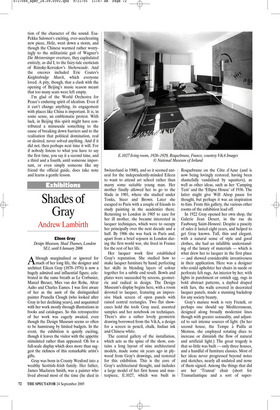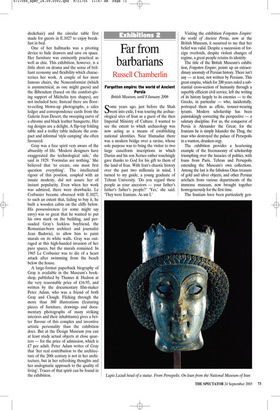Shades of Gray
Andrew Lambirth
Eileen Gray
Design Museum, Shad Thames, London SE1, until 8 January 2006
Although marginalised or ignored for much of her long life, the designer and architect Eileen Gray (1878–1976) is now a hugely admired and influential figure, celebrated in the same breath as Le Corbusier, Marcel Breuer, Mies van der Rohe, Alvar Aalto and Charles Eames. I was first aware of her as the aunt of the distinguished painter Prunella Clough (who looked after Gray in her declining years), and acquainted with her work mostly through illustrations in books and catalogues. So this retrospective of her work was eagerly awaited, even though the Design Museum seems so often to be hamstrung by limited budgets. In the event, the exhibition is quietly exciting, though it leaves the visitor with the appetite stimulated rather than appeased. Oh for a full-scale display which does more than suggest the richness of this remarkable artist’s gifts.
Gray was born in County Wexford into a wealthy Scottish–Irish family. Her father, James Maclaren Smith, was a painter who lived abroad most of the time (he died in Switzerland in 1900), and so it seemed natural for the independently-minded Eileen to want to attend art school rather than marry some suitable young man. Her mother finally allowed her to go to the Slade in 1901, where she studied under Tonks, Steer and Brown. Later she escaped to Paris with a couple of friends to study painting in the academies there. Returning to London in 1905 to care for her ill mother, she became interested in lacquer techniques, which were to occupy her principally over the next decade and a half. By 1906 she was back in Paris and, apart from a brief sojourn in London during the first world war, she lived in France for the rest of her life.
Her lacquer work first established Gray’s reputation. She studied how to make lacquer furniture by hand, perfecting her skills in blending layers of colour together for a subtle end result. Bowls and plates were succeeded by screens, geometric and radical in design. The Design Museum’s display begins here, with a room devoted to lacquer, featuring an impressive black screen of open panels with raised central rectangles. Two flat showcases hold the tools Gray used, assorted samples and her notebook on techniques. There’s also a rather lovely geometric drawing borrowed from the V&A, a design for a screen in pencil, chalk, Indian ink and Chinese white.
The central gallery of the installation, which acts as the spine of the show, contains a long layout of nine architectural models, made some six years ago in plywood from Gray’s drawings, and restored for this exhibition. This is the core of Gray’s architectural thought, and includes a large model of her first house and masterpiece, E.1027, which was built in Roquebrune on the Côte d’Azur (and is now being lovingly restored, having been shamefully vandalised by squatters), as well as other ideas, such as her ‘Camping Tent’ and the ‘Ellipse House’ of 1936. The latter might give Will Alsop pause for thought, but perhaps it was an inspiration to him. From this gallery, the various other rooms of the exhibition lead off.
In 1922 Gray opened her own shop, the Galerie Jean Desert, in the rue du Faubourg Saint-Honoré. Despite a paucity of sales it lasted eight years, and helped to get Gray known. Tall, thin and elegant, with a natural sense of style and good clothes, she had an infallible understanding of the luxury of materials — which is what drew her to lacquer in the first place — and showed considerable inventiveness in their application. Here was a designer who could upholster her chairs in suede or perforate felt rugs. An interior by her, with lights in parchment or ostrich egg, rugs in bold abstract patterns, a daybed draped with furs, the walls covered in decorated lacquer panels, made a stunning backdrop for any society beauty.
Gray’s mature work is very French, or perhaps one should say Mediterranean, designed along broadly modernist lines though with greater sensuality, and adjusted to suit intense sources of light. (In her second house, the Tempe à Pailla at Menton, she employed rotating discs to increase or diminish the flow of natural and artificial light.) The great tragedy is that so little was built — only three houses, and a handful of furniture classics. Most of her ideas never progressed beyond notes and sketches, nearly all undated and none of them signed. Among the things that did are her ‘Transat’ chair (short for Transatlantique and a sort of super deckchair) and the circular table first made for guests in E.1027 to enjoy breakfast in bed.
One of her hallmarks was a pivoting device to hide drawers and save on space. Her furniture was eminently practical as well as chic. This exhibition, however, is a little short on drama and the sense of brilliant economy and flexibility which characterises her work. A couple of her most famous chairs, the Nonconformist (which is asymmetrical, as one might guess) and the Bibendum (based on the comfort-giving support of Michelin tyre shapes), are not included here. Instead there are floorto-ceiling blown-up photographs, a sales ledger and correspondence cards from the Galerie Jean Desert, the sweeping curve of a chrome and black leather banquette. Her rug designs are a delight. A flip-top folding table and a trolley table indicate the compact and informal ‘style camping’ she often favoured.
Gray was a free spirit very aware of the absurdity of life. ‘Modern designers have exaggerated the technological side,’ she said in 1929. ‘Formulas are nothing.’ She believed that ‘to create, one must first question everything’. The intellectual rigour of this position, coupled with an innate modesty, did not assure her of instant popularity. Even when her work was admired, there were drawbacks. Le Corbusier became obsessed with E.1027, to such an extent that, failing to buy it, he built a wooden cabin on the cliffs below. His possessiveness (or some might say envy) was so great that he wanted to put his own mark on the building, and persuaded Gray’s feckless boyfriend, the Romanian-born architect and journalist Jean Badovici, to allow him to paint murals on its white walls. Gray was outraged at this high-handed invasion of her pure spaces, but the murals remained. In 1965 Le Corbusier was to die of a heart attack after swimming from the beach below the house.
A large-format paperback biography of Gray is available in the Museum’s bookshop, published by Thames & Hudson at the very reasonable price of £16.95, and written by the documentary film-maker Peter Adam, who was a friend of both Gray and Clough. Flicking through the more than 300 illustrations (featuring pieces of furniture, drawings and documentary photographs of many striking interiors and their inhabitants) gives a better flavour of this complex and inventive artistic personality than the exhibition does. But at the Design Museum you can at least study actual objects at close quarters — for the price of admission, which is £7 per adult. Peter Adam writes of Gray that ‘her real contribution to the architecture of the 20th century is not in her architecture, but in her refreshing thoughts and her undogmatic approach to the quality of living’. Traces of that spirit can be found in the exhibition.

































































 Previous page
Previous page